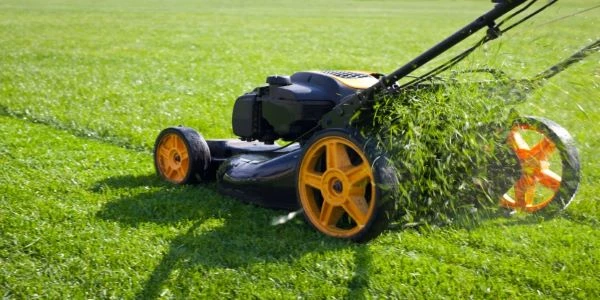The Grounds Guys provide expert advice on optimal lawn cutting heights for healthy grass growth.
|
At one time or another we’ve all asked ourselves this question: “How short can I cut my lawn without damaging it?” Well, the correct answer depends on several factors, such as the type of grass, the time of the year, and how frequently you mow your lawn. Typically, cool season grasses should be cut to 3 to 4 inches, and warm-season grasses should be cut to about 2 to 2.5 inches. During the warmer months, the taller heights shade the soil and protect the roots of your lawn from the harsh heat. In order to get a better understanding of what your lawn needs to stay lush and healthy all year round, here are some things you should know. 
Grass Type and Height
It may not seem like a big deal to adjust the height of your lawn an inch or two every so often, but it can actually be detrimental to the overall health of your lawn depending on the type of grass. Different grasses have different needs, so it’s important to know your lawn on a first-name basis. Grasses that are found in colder climates, such as Kentucky bluegrass, perennial ryegrass, creeping bentgrass, and tall fescue, are considered cool-season grasses. They should be mowed to around 4 inches to shade the soil and keep roots cool during hot periods. In the warmer regions, warm-season grasses like Bermuda, centipede, and zoysia grass are typically best kept around 2 to 2.5 inches.
Related Topic: Can Lawn Fertilizer Harm My Pet?
Don’t Go Too Low
Some individuals prefer to cut grass lower so they don’t have to mow as frequently. As tempting as this may be, mowing your grass too low can be damaging to your lawn’s health. Not only does mowing your lawn too low stress out your grass, but it can also reduce the density of your grass, making your lawn a tempting haven for invasive weeds. Lawn weeds like crabgrass and foxtail need sunlight to grow. When you cut your lawn too short, sunlight can reach the soil and promote the growth of weeds. But when you have longer grass, it keeps those pesky weed seeds starved of sunlight so your lawn can remain the star of the show. Longer grass not only helps keep weeds at bay, it also helps stave off damage inflicted by relentless summer heat!
One Third Rule
No matter what type of grass you have, you should never remove more than one-third of the height in a single mowing. Why? Well, it’s easy to forget that grass is a living plant and grass still undergoes stress when it’s cut. Stressed-out grass can cause a myriad of problems, so the best way to avoid cutting too much grass off is by knowing what height is ideal for your lawn. Then, allow it to grow one-third longer than the ideal height prior to mowing.
Mowing Frequency
When you cut grass too short, it’s an invitation for weeds, drought damage, and heat damage. But if you keep your grass too long, you may create an ideal habitat for mosquitoes and critters. With all these different factors, how do you know how frequently you should mow your lawn? While it is common for many people to stick to a mowing schedule that’s based on their climate, season, and the current weather conditions, you’ll probably only need to mow every five to seven days. Knowing your lawn's requirements and its ideal height will ultimately determine how frequently it should be cut.
Related Topic: How to Revive Dead Grass
Professional Lawn Maintenance
Not only does a stunning lawn add value to your property, it also feels good! Having a lush, well-manicured lawn may take some trial and error, but it’s worth the effort. If you don’t have the time or patience to determine the ideal height for your lawn, The Grounds Guys can help. We have the knowledge and experience to keep your lawn green, vibrant and healthy all year round. We provide exceptional residential lawn maintenance and service, ranging from mowing to fertilization and more!
Find The Grounds Guys location near you to request a free estimate today!